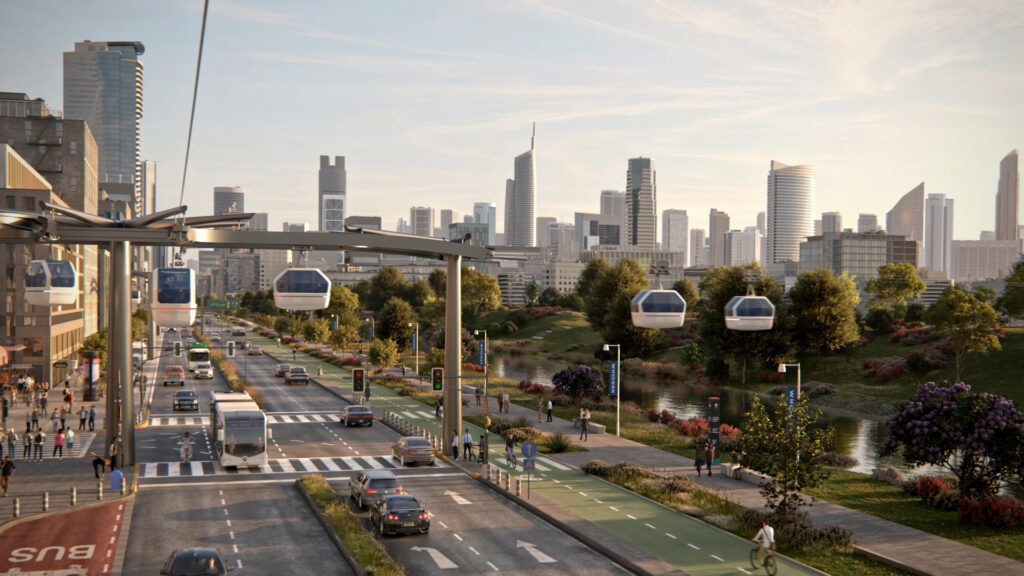Okay, this is a new one.
Transportation planners have a new idea about how to take on congestion as Dallas-Fort Worth’s population grows: elevated autonomous cable cars that riders can hail on demand.
Five North Texas cities — Dallas, Arlington, Plano, Frisco and DeSoto — are vying to become the first in the U.S. to pilot the novel transportation system known as Whoosh. The system consists of electric vehicles that resemble conventional aerial gondolas but use autonomous technology to move along an elevated network of fixed cables and rails. The concept comes from Swyft Cities, a project that was born at Google but was spun out as an independent business aimed at innovating transit.
The company has been working with the North Central Texas Council of Governments to identify potential sites. Swyft Cities will choose which would be the best fit for the project’s first run.
[…]
Like buses, Whoosh vehicles would have predetermined stops on the ground, with the system initially covering about a three-mile radius — more stops could be added later. But unlike buses or trains, the on-demand nature means it would bypass all the existing stops to take riders directly to their designated one. Since it’s elevated, it also bypasses, rather than competing with, road traffic.
While each potential site has unique needs, Whoosh is a good fit for mid-density areas like the edges of a downtown — places that lack good last-mile transit solutions.
“The core of downtown is probably pretty well served by other modes, but there’s a whole lot places outside of downtown Dallas and Fort Worth that doesn’t have good solutions,” said Jeral Poskey, Swyft Cities CEO.
Swyft Cities chose North Texas because of an NCTCOG program that looks to attract new transit technology to the region and connect them with local governments. Staff at the transportation planning agency vet the companies first, making sure they offer potential solutions to some of DFW’s transportation challenges.
While cost depends on the specifications of each system, the buildout of a Whoosh system should take around $30–$50 million. Cities are in the process of applying for funding grants. Those should come to fruition around this time next year, along with system plans.
You can look at the Swyft Cities webpage for a bunch of whiz-bang pictures and whatnot. I couldn’t find any news stories about other locations that may be looking to kick the tires (as it were) on these things, so I can’t give you much in terms of how hot this is. It looks cool, but it also looks like a lot of infrastructure that I have a hard time believing would come in at that price tag. You’d also need some awfully wide sidewalks or other available surface-level space to put up those gondolas. Probably not a surprise that Houston is not on that short list for possible beta testers, and that’s without taking how utterly non–visionary our current Metro Board is. I have no idea if this is the actual Next Big Thing or a bunch of hyperloop-level nonsense, but at least it’s something other than building more road lanes. I’ll buy the hope, at least for now.


Hi Charles, thanks for the mention and glad to address the questions you pose. Two prototypes have already been built — one in Silicon Valley and one in New Zealand — that tested out the concept, costs, build time, scalability, etc. The hardware pilot will break ground soon at a recreational tourism development in New Zealand. Believe me, we’re keenly aware of the siren song of over-promising when it comes to new technologies. Hyperloops have come and gone. Electric air taxis MIGHT start happening next year. Meanwhile, self-driving cars are years behind what was originally promised. That said, we feel one of the many advantages of our solution is that infrastructure has a very low ground-level footprint Primarily, it’s support posts every couple of hundred feet to elevate the cables. Stations can be the size of bus stops. Our goal is to move mobility off of street level, and relieve pressures on car-based infrastructure, such as streets, highways, parking, etc. We also want to make mass transit work better, by feeding more riders into it. Many transit agencies still haven’t fully recovered from pandemic effects. But as with any new technology, questions and even skepticism can be healthy. I mean, many years ago, they promised us jetpacks, right?! Feel free to reach out to me at leonard@swyftcities.com. Appreciate the interest, and would love to keep you updated on our progress.
I think it’s more of a Shelbyville idea.
I can’t think of anything worse than being trapped in a cable car terrarium above a City street in late July in Dallas in 100F heat with a snapped guidewire somewhere that shuts down my planned route.